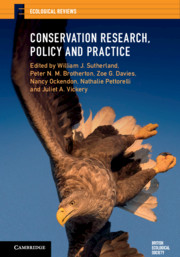21 results
Part I - Identifying priorities and collating the evidence
-
- Book:
- Conservation Research, Policy and Practice
- Published online:
- 18 April 2020
- Print publication:
- 16 April 2020, pp 27-142
-
- Chapter
-
- You have access
- Open access
- HTML
- Export citation
Chapter One - Making a difference in conservation: linking science and policy
- from Introduction and scene setting
-
-
- Book:
- Conservation Research, Policy and Practice
- Published online:
- 18 April 2020
- Print publication:
- 16 April 2020, pp 3-8
-
- Chapter
-
- You have access
- Open access
- HTML
- Export citation
Chapter Twenty - Successfully translating conservation research into practice and policy: concluding thoughts
- from Conclusion
-
-
- Book:
- Conservation Research, Policy and Practice
- Published online:
- 18 April 2020
- Print publication:
- 16 April 2020, pp 325-328
-
- Chapter
-
- You have access
- Open access
- HTML
- Export citation
Part II - Influencing and making decisions
-
- Book:
- Conservation Research, Policy and Practice
- Published online:
- 18 April 2020
- Print publication:
- 16 April 2020, pp 143-262
-
- Chapter
-
- You have access
- Open access
- HTML
- Export citation
Contents
-
- Book:
- Conservation Research, Policy and Practice
- Published online:
- 18 April 2020
- Print publication:
- 16 April 2020, pp vii-ix
-
- Chapter
-
- You have access
- Open access
- HTML
- Export citation
Contributors
-
- Book:
- Conservation Research, Policy and Practice
- Published online:
- 18 April 2020
- Print publication:
- 16 April 2020, pp x-xvi
-
- Chapter
-
- You have access
- Open access
- HTML
- Export citation
Part III - Communicating the message
-
- Book:
- Conservation Research, Policy and Practice
- Published online:
- 18 April 2020
- Print publication:
- 16 April 2020, pp 263-322
-
- Chapter
-
- You have access
- Open access
- HTML
- Export citation
Introduction and scene setting
-
- Book:
- Conservation Research, Policy and Practice
- Published online:
- 18 April 2020
- Print publication:
- 16 April 2020, pp 1-26
-
- Chapter
-
- You have access
- Open access
- HTML
- Export citation
Plate Section (PDF Only)
-
- Book:
- Conservation Research, Policy and Practice
- Published online:
- 18 April 2020
- Print publication:
- 16 April 2020, pp 337-356
-
- Chapter
-
- You have access
- Open access
- HTML
- Export citation

Conservation Research, Policy and Practice
-
- Published online:
- 18 April 2020
- Print publication:
- 16 April 2020
-
- Book
-
- You have access
- Open access
- Export citation
Copyright page
-
- Book:
- Conservation Research, Policy and Practice
- Published online:
- 18 April 2020
- Print publication:
- 16 April 2020, pp vi-vi
-
- Chapter
-
- You have access
- Open access
- HTML
- Export citation
Conclusion
-
- Book:
- Conservation Research, Policy and Practice
- Published online:
- 18 April 2020
- Print publication:
- 16 April 2020, pp 323-328
-
- Chapter
-
- You have access
- Open access
- HTML
- Export citation
Index
-
- Book:
- Conservation Research, Policy and Practice
- Published online:
- 18 April 2020
- Print publication:
- 16 April 2020, pp 329-336
-
- Chapter
-
- You have access
- Open access
- HTML
- Export citation
Action before certainty for Africa's European migrant birds
-
- Article
-
- You have access
- HTML
- Export citation
Population status of four endemic land bird species after an unsuccessful rodent eradication on Henderson Island
-
- Journal:
- Bird Conservation International / Volume 29 / Issue 1 / March 2019
- Published online by Cambridge University Press:
- 10 April 2018, pp. 124-135
-
- Article
-
- You have access
- HTML
- Export citation
The nature and extent of terrestrial protected area coverage on the UK's Overseas Territories
- Part of
-
- Journal:
- Environmental Conservation / Volume 44 / Issue 4 / December 2017
- Published online by Cambridge University Press:
- 22 March 2017, pp. 397-404
-
- Article
- Export citation
The importance of protected and unprotected areas for colony occupancy and colony size in White-necked Picathartes Picathartes gymnocephalus in and around Gola Rainforest National Park, Sierra Leone
-
- Journal:
- Bird Conservation International / Volume 27 / Issue 2 / June 2017
- Published online by Cambridge University Press:
- 14 November 2016, pp. 244-255
-
- Article
-
- You have access
- HTML
- Export citation
Defining the key wintering habitats in the Sahel for declining African-Eurasian migrants using expert assessment
-
- Journal:
- Bird Conservation International / Volume 24 / Issue 4 / December 2014
- Published online by Cambridge University Press:
- 24 February 2014, pp. 477-491
-
- Article
-
- You have access
- HTML
- Export citation
Chapter Seven - The importance of habitat heterogeneity at multiple scales for birds in European agricultural landscapes
-
-
- Book:
- Birds and Habitat
- Published online:
- 05 December 2012
- Print publication:
- 08 November 2012, pp 177-204
-
- Chapter
- Export citation

